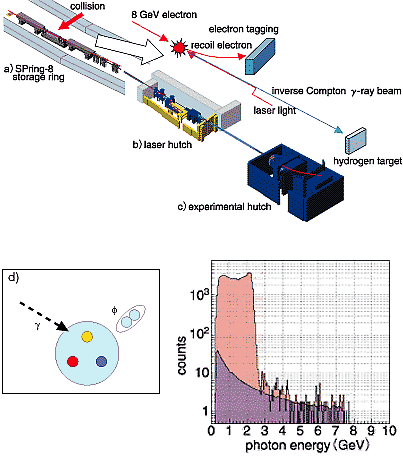 |
||
|
| Protons and neutrons are called "nucleons", each of which consists of quarks and gluons. Gamma-rays with a wavelength of 0.1 - 0.5 fm become a good probe to study the inside of a nucleon the size of which is about 2 fm. In high-energy gamma-ray spectroscopy, we investigate the properties of nucleons and nuclei through the photo production of mesons or the scattering of gamma-rays. Inverse Compton gamma-rays can be generated via the collision between a laser-light photon and a high-energy electron. This is a typical Lorenz contraction effect of the special relativity theory. At SPring-8, we succeeded in obtaining high-energy gamma-rays the energy of which is a factor of 700 million greater than the energy of the incident laser. This high-energy gamma-ray has an excellent property of linear and circular polarizations and its maximum energy reaches 2.4 GeV. Compared with those in France and the USA, the generated gamma-rays are of the highest class in the world, and enable the inside of the nucleon to be investigated. Figure 1-5 shows a schematic drawing of the instrument for generating inverse Compton gamma-rays at SPring-8. Laser light is injected from the laser hutch. The distance between the laser hutch and the collision point is 30 m. The laser light hits the electron beam, the size of which is less than 0.2 mm, like a needle. Laser light is reflected by an electron just as light is reflected by a mirror. Due to the Lorenz effect of the special relativity theory, the laser light gets energy from the 8 GeV electron. The energy multiplication factor reaches 700 million. The measured energy spectrum is shown in Fig. 1-5(e). The electron, which loses energy due to the laser collision, is detected by the electron tagging system, and its energy loss is measured. The gamma-ray beam passes through the laser hutch and irradiates a hydrogen target. The gamma-ray beam is an excellent probe to investigate the inside structure of a proton. Thanks to this success of generating a polarized high-energy gamma-ray beam, the precise study of the quark-gluon structure of a nucleon is feasible via the observation of f meson production. |
| Reference M. Fujiwara et al., Physics with Polarized Photons at SPring-8, Acta Phys. Pol., B, 29(1-2), 141 (1998). |
| Select a topic in left column |
|
Persistent Quest-Research Activities 2000 Copyright(c)Japan Atomic Energy Research Institute |